The Impact of Saigneé on Wine Quality (2017)
Matthieu Finot
King Family Vineyards
Summary
This study examines the impact of saigneé on Merlot wine quality. Merlot grapes were harvested from the same block on the same day and was split into 4 T Bins. The T Bins received the following treatments: 1) 0% Saigneé, 2) 7% Saigneé, 3) 15% Saigneé, and 4) 25% Saigneé. All other treatments between wines were identical. Brix and pH slightly increased by saigneé, and TA slightly decreased in the must. Wine chemistry was not much affected by saigneé. Color intensity increased with increasing saigneé. Anthocyanin and tannin were also increased by saigneé. These increases were generally correlated to increasing levels of saigneé. Overall, the higher rates of saigneé may have slightly increased Fruit Intensity, Herbaceous/Green character, Bitterness, and Astringency. The higher rates of saigneé tended to be more preferred (although preferences changed between tastings). Saigneé may prove to be a valuable tool in Virginia red winemaking and should be examined at many different sites among many different varieties.
Introduction
Saigneé is French for “bleed,” and is the process whereby a portion of free-run juice is removed from crushed red grapes in an attempt to increase the solids to juice ratio. This alteration of the skin to juice ratio is meant to simulate smaller berry size, which is often thought to be a marker for high quality berries (Singleton 1972). Anecdotally, saigneé is thought to concentrate flavor and phenols, or to counter water additions meant to lower alcohol content. This is because anthocyanins and, to a lesser extent, phenols and other phenolic compounds begin to be extracted from crushed grapes in 30 minutes to one hour. As a result, juice that is removed prior to this time is very low in concentration of these compounds, allowing for potential further concentration of these compounds later through a higher skin to juice ratio. Saigneé can concentrate all flavors, including green flavors and other off flavors (Ritchie; Gardner 2015). Saigneé may lower the YAN of the juice and may as well lower the TA of the must. Generally, only 5-10% saigneé is performed on good quality, non-watered down grapes, and up to 30% may be necessary for berries with much more water dilution (due to rain events, perhaps) (Ritchie).
Many studies have found that saigneé increases anthocyanins and tannin in finished wine (Singleton 1972; Gerbaux 1993; Zamora et al. 1994; Gawel et al. 2001; Sacchi et al. 2005; Fanzone et al. 2013; Casassa et al. 2016; Wu et al. 2017). Saigneé wines may result in more and larger polymeric pigment and tannin, as well as slightly higher color and phenolics (Gerbaux 1993; Sacchi et al. 2005). This would suggest higher color stability. However, some studies suggest that the long-term stability of the anthocyanins and phenolics may be negligible compared to no saignee, as after 6 months the levels seem to approach each other (Gawel et al. 2001; Harbertson et al. 2009). Saignee, therefore, may just be a young wine effect (Sacchi et al. 2005). Saigneé may also favor an increased extraction of seed tannin relative to control wines (Harbertson et al. 2009), but this is not always the case (Casassa et al. 2016). Saigneé may also be used to counteract the phenolic and aromatic dilution effect of adding water to high Brix musts (Harbertson et al. 2009). In some cases, only high amounts of saigneé (up to 30%) can have a significant effect on anthocyanin concentration (Fanzone et al. 2013). Although the phenolic attributes of wines are often changed by saignee, judges cannot always tell the difference (Fanzone et al. 2013).
Other wine parameters can be increased by saigneé as well, such as potassium, pH, aromatic intensity, color, astringency, and overall wine quality (Figure 1) (Singleton 1972). However, this is not always the case, as one study found that a 14% saigneé may not result in general chemistry differences except for a slightly lower TA (which disappeared after a year) (Wu et al. 2017). The increase in pH and decrease in TA is likely due to increased potassium concentration resulting from a higher solids:juice ratio. This may also explain why other chemistry parameters are not as much affected, as other parameters such as Brix are not impacted as much by skin contact but instead come out solely with the juice.
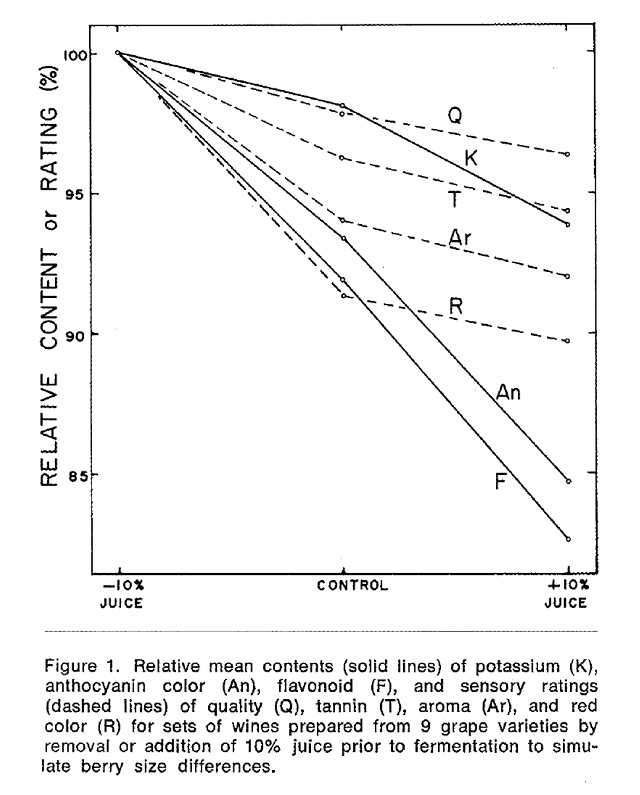
Adapted from Singleton 1972
The purpose of this study is to investigate how differing levels of saignee impact Merlot wine chemistry and quality.
Results and Discussion
Brix and pH slightly increased by saigneé, and TA slightly decreased in the must. Wine chemistry was not much affected by saigneé. Color intensity increased with increasing saigneé. Anthocyanin and tannin were also increased by saigneé. These increases were generally correlated to increasing levels of saigneé.
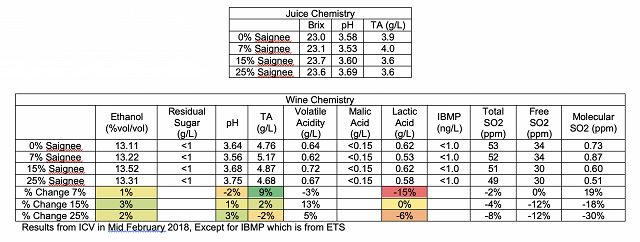
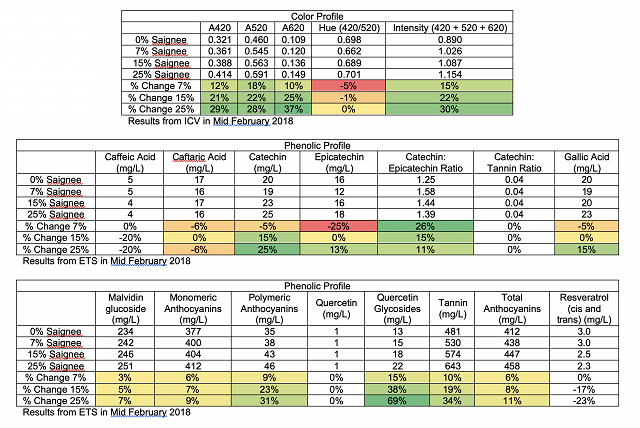
For the descriptive analysis on February 28, there were no strong trends for the descriptors used in this study. The 15% and 25% saigneé may have had slightly higher Astringency. There was a slight preference for the 25% Saigneé wine, followed by either the 7% or the 0% Saigneé.
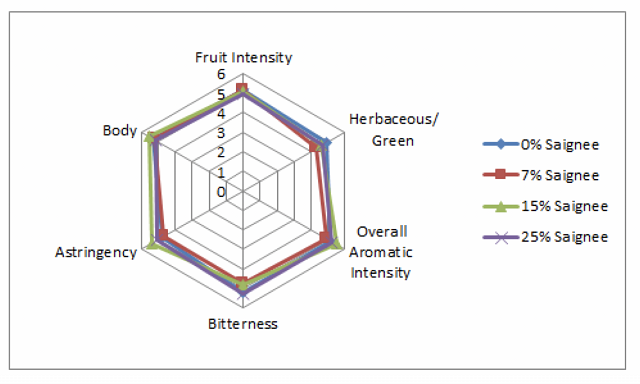
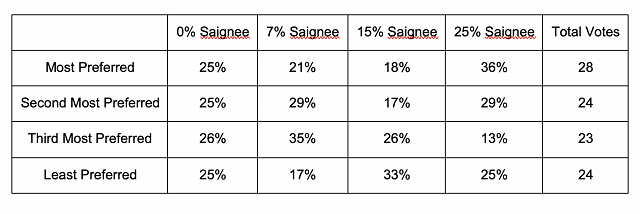
For the March 14 tasting, there was a slight tendency for 25% saigneé to have more Bitterness, Astringency, and Herbaceous/Green character. The 7% saigneé seemed to be least in these regards and was perhaps slightly preferred. However, there were not many judges at this tasting and so these results are weak.
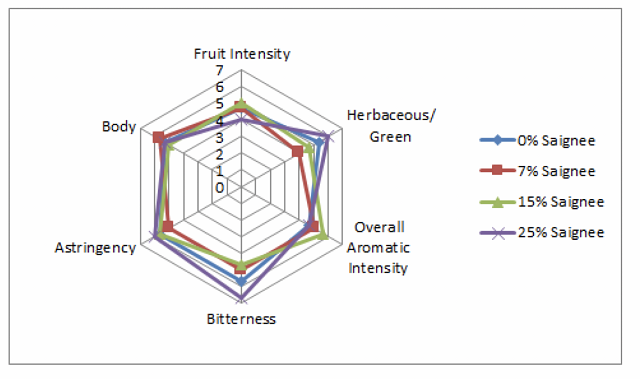
For the descriptive analysis on April 4, there were no strong trends for the descriptors used in this study. There was a slight tendency for the higher rates of saigneé to have higher Fruit Intensity, Herbaceous/Green character, Bitterness, and Astringency. In general, the 15% saginee seemed to be the most preferred, and the 7% and 0% were second most preferred.
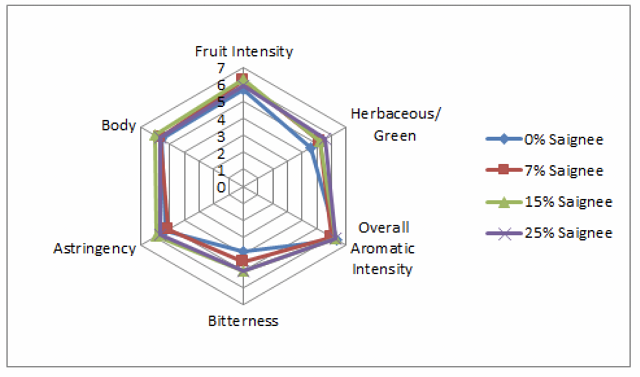

Overall, the higher rates of saigneé may have slightly increased Fruit Intensity, Herbaceous/Green character, Bitterness, and Astringency. The higher rates of saigneé tended to be more preferred (although preferences changed between tastings). Saigneé may prove to be a valuable tool in Virginia red winemaking and should be examined at many different sites among many different varieties.
Methods
Merlot grapes from the same block were harvested and processed on September 25, 2017. The Merlot grapes were split into 4 different T Bins, each receiving the following treatment:
- 0% Saigneé
- 7% Saigneé
- 15% Saigneé
- 25% Saigneé
Saigneé was performed just after crush. All other treatments were the same. 15ppm sulfur dioxide was added to the musts, and then they were inoculated with 0.15g/L D80 yeast. Each bin was punched down twice per day.
The wine was pressed on October 10 into separate tanks, allowed to settle, and then racked to barrel the following day. Malolactic conversion commenced on November 2. On November 23, each wine received 0.03g/L Stab Micro and 66ppm sulfur dioxide.
These projects were tasted on February 28, March 14, and April 4, 2018. In order to balance the data set to perform statistical analysis for descriptive analysis on the February 28 tasting, any judge who had not fully completed the descriptive analysis ratings were removed. In order to then make the number of judges between groups equivalent, one judge from group 2 was transferred to group 1, and another judge from group 2 was eliminated. This resulted in a final data set of 3 groups, each with 8 judges (considered as replications within groups, and groups were considered as assessors). Data was analyzed using Panel Check V1.4.2. Because this is not a truly statistical set-up, any results which are found to be statistically significant (p<0.05) will be denoted as a “strong trend” or a “strong tendency,” as opposed to general trends or tendencies. The statistical significance here will ignore any other significant effects or interactions which may confound the results (such as a statistically significant interaction of Judge x Wine confounding a significant result from Wine alone). The descriptors used in this study were Fruit Intensity, Herbaceous/Green, Overall Aromatic Intensity, Bitterness, Astringency, and Body.
Due to the very small number of judges (3) at the March 14 tasting, only slight trends will be discussed for the sensory information.
The same procedures for data analysis were used on the April 4 tasting. For the descriptive analysis in this tasting, one judge was eliminated from group two so that each group had 3 judges, for a total of 9 judges.
References
Casassa, L.Fl, Larsen, R.C., and Harbertson, J.F. 2016. Effects of vineyard and winemaking practices impacting berry size on evolution of phenolics during winemaking. Am. J. Enol. Vitic.
Fanzone, M., Assof, M., Peña-Neira, Á, Zamora, F., and Jofré, V. 2013. Effect of saignee on phenolic composition of Malbec wines. Revistade la Facultad de Ciencias Agrarias. 45:199-209.
Gardner, D.M. 2015. Winemaking practices believed to affect red wine color stability. Wine & Grapes U. <https://psuwineandgrapes.wordpress.com/2015/05/08/winemaking-practices-believed-to-affect-red-wine-color-stability/>
Gawel, R., P.G. Iland, P.A. Leske, and C.G. Dunn. 2001. Compositional and sensory differences in Syrah wines following juice runoff prior to fermentation. J. Wine Res. 12:5-18.
Gerbaux, V. 1993. Etude de quelques conditions de cuvaison susceptibles d’augmenter la composition polyphénolique des vins de Pinot noir. Rev. Oenol. 69:15-18.
Harbertson, J.F, Mireles, M.S. Harwood, E.D., Weller, K.M., and Ross, C.F. 2009. Chemical and sensory effects of saignée, water addition, and extended maceration on high brix must. Am. J. Enol. Vitic. 60:450-460
Ritchie, G.C. What is saignée and how will it affect my red wine?
Sacchi, K.L, Bisson, L.F., and Adoms, D.O. 2005. A review of the effect of winemaking techniques on phenolic extraction in red wines. Am. J. Enol. Vitic. 56:197-206
Singleton, V.L. 1972. Effects on red wine quality of removing juice before fermentation to simulate variation in berry size. Am. J. Enol. Vitic. 23:106-113.
Wu, Y., Xing, K., Zhang, X., Wang, H., Wang, F., Wang, Y., and Li, J. 2017. Effect of pre-fermentation saignée treatment on phenolic ocmpound profile in wine made of Cabernet Sauvignon. J. Food Biochem.
Zamora, F., G. Luengo, P. Margalef, M. Magriña, and L. Arola. 1994.Nota. Efecto del sangrado sobre el color y la composición en compuestos fenólicos del vino tinto. Rev. Esp. Cienc. Tecnol. Aliment. 34:663-671.
